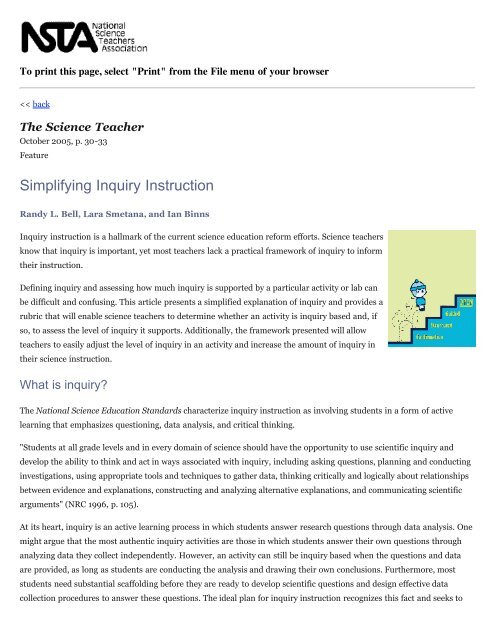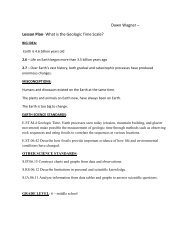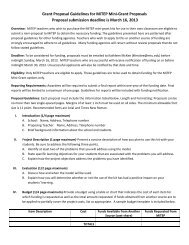Simplifying Inquiry Instruction
Simplifying Inquiry Instruction - IHMC Public Cmaps
Simplifying Inquiry Instruction - IHMC Public Cmaps
- No tags were found...
Create successful ePaper yourself
Turn your PDF publications into a flip-book with our unique Google optimized e-Paper software.
To print this page, select "Print" from the File menu of your browser<br />
help students progress to greater inquiry skills through a series of graduated steps, as described later in this article.<br />
<strong>Inquiry</strong> or not?<br />
The first question to ask when determining whether an activity is inquiry based is, “Are students answering a research<br />
question through data analysis?” Many worthwhile hands-on activities traditionally performed in science classrooms do<br />
not involve a research question or data analysis. For example, constructing models of cells or atoms, assembling a<br />
wildflower collection, or constructing a scale model of the solar system can all be excellent activities. However, as<br />
traditionally taught, these activities do not involve research questions and therefore do not qualify as inquiry activities.<br />
For the same reason, activities designed to give practice with a particular skill, such as learning to use a triple beam<br />
balance or reading a graduated cylinder, do not constitute inquiry. <strong>Inquiry</strong>-based activities must start with a scientific<br />
question. For example:<br />
How does the amount of a substance affect its density?<br />
How does temperature affect the rate of a chemical reaction?<br />
Did the latest El Niño impact the climate where I live?<br />
In what ways does the Moon’s shape and position in the sky change over the course of a month?<br />
In addition to having a research question, inquiry activities must involve students in analyzing relevant data.<br />
Consequently, having students conduct research by solely searching library or internet resources does not constitute an<br />
inquiry lesson. In these activities, students are gathering information but are not analyzing data to answer their questions<br />
of interest. On the other hand, do inquiry-based activities always involve students in collecting their own data? Not<br />
necessarily. Students can analyze data collected by the teacher or data available on the internet, provided that students<br />
answer their research question through their own data analysis.<br />
Figure 1 presents several examples for teachers to test their understanding of inquiry-based activities. Before continuing<br />
with this article, read and consider each of the scenarios in Figure 1 and decide whether or not each is an example of<br />
inquiry. After reading through the scenarios, you may recognize that activities 1a, 2a, and 2b do not support inquiry.<br />
Example 1a can be a meaningful and engaging hands-on activity, but does not involve a research question. Examples 2a<br />
and 2b imply a research question, but do not involve students in analyzing data. Instead, students are merely<br />
summarizing the conclusions of others. No doubt these types of activities have a place in the science classroom; however,<br />
they should not be confused with inquiry labs.<br />
Figure 1.Teacher inquiry self-check.<br />
Which examples constitute inquiry?<br />
1a. Students<br />
complete a Moon<br />
phase calendar by<br />
cutting out<br />
photographs<br />
of the Moon<br />
in different<br />
phases,<br />
mounting<br />
them on a<br />
monthly<br />
1b. After completing a pre-assessment<br />
activity on students’ knowledge of Moon<br />
phases, a student asks about the correct<br />
order of Moon phases. The teacher<br />
challenges students to determine the<br />
sequence of phases by observing the<br />
Moon and recording their observations for<br />
one month.<br />
1c. The teacher begins with the question “Does the Moon rise<br />
and set at the same time every night?” Following a brief<br />
discussion of the question, the teacher demonstrates the rising<br />
and setting of the Moon for several sequential evenings using<br />
a computer simulation. The teacher then facilitates a class<br />
discussion in which the class concludes that the Moon rises<br />
and sets about 50 minutes later each evening.
calendar on<br />
the proper<br />
date, and<br />
labeling<br />
each of the<br />
eight major<br />
Moon<br />
phases.<br />
2a. Students define<br />
and describe the El<br />
Niño effect by using<br />
text and images<br />
they find on the<br />
internet.<br />
2b. Students go to the library to find<br />
newspaper accounts describing the impact<br />
of El Niño on the California coast. They<br />
then summarize what they find in a twopage<br />
written report.<br />
2c. Students select a location in the U.S. then search the<br />
Internet for monthly temperature data of this location for the<br />
most recent El Niño year. Students then compare monthly<br />
temperature data for the El Niño year to the average<br />
temperature data for the past 50 years in order to assess the<br />
impact of El Niño on that particular location.<br />
Examples 1b, 1c, and 2c entail both a research question and data analysis and thus support inquiry learning. In Example<br />
1b, the teacher provides the question, “What are the phases of the Moon?” Student answers to the question are based on<br />
analysis of their own Moon observations. In Example 1c, an inquiry lesson is incorporated into a teacher-led<br />
demonstration. Although the teacher presents the data using a computer simulation, students are involved as a class in<br />
analyzing the virtual observations. Example 2c challenges students to answer the question, “What is El Niño’s impact on<br />
the climate at a given locality?” Students answer that question based on analysis of data collected on the internet.<br />
All inquiry is not created equal<br />
It is important to realize that not all inquiry activities are created equal. The concept of different levels of inquiry was first<br />
described by Schwab (1962). Later, Herron identified three levels of openness for inquiry in science activities (1971). More<br />
recently, Rezba, Auldridge, and Rhea (1999) have developed a four-level model of inquiry instruction based on the work<br />
by Schwab and Herron. Finally, an even more detailed inquiry rubric can be found in <strong>Inquiry</strong> and the National Science<br />
Education Standards (NRC 2000, p. 29, Tables 2–6).<br />
Amount of information provided<br />
Figure 2 presents a modified version of the four-level model of inquiry we use to<br />
assess our instructional activities. The four-level model illustrates how inquirybased<br />
activities can range from highly teacher directed to highly student<br />
centered, based on the amount of information provided to the student. The<br />
salient feature of this model is the question, “How much information is given to<br />
the student?”<br />
Using this framework as a guide, lab activities can be designed at varying levels<br />
of inquiry, depending on wording and presentation. This model allows the<br />
teacher to tailor inquiry lessons to the particular readiness levels of the class. For<br />
Figure 2. Modified version of the fourlevel<br />
model of inquiry. How much<br />
information is given to the student?<br />
Level<br />
of<br />
inquiry<br />
Question? Methods? Solution?<br />
1 x x x<br />
2 x x<br />
3 x<br />
instance, a Level 1 activity can become a Level 2 by having students complete it prior to learning the targeted concept,<br />
and a Level 2 activity can be revised easily to Level 3 simply by removing the procedural directions.<br />
4<br />
Complexity<br />
The degree of complexity in an inquiry activity also varies, depending on the level of openness and the cognitive demands<br />
required (Figure 3). The simplest, Level 1, is sometimes referred to as a confirmation activity. At this level, students are
equired (Figure 3). The simplest, Level 1, is sometimes referred to as a confirmation activity. At this level, students are<br />
provided the question and procedure, and the expected results are known in advance. For instance, lab activities<br />
presented at the end of the chapter to verify a concept that has already been taught fall into this category.<br />
Figure 3. Levels of inquiry in an effervescent antacid tablet activity. Reprinted with permission from Rezba, Auldridge, and<br />
Rhea (1999).<br />
<strong>Inquiry</strong><br />
level<br />
Description and examples<br />
1 Confirmation—Students confirm a principle through an activity in which the results are known in advance.<br />
“In this investigation you will confirm that the rate of a chemical reaction increases as the temperature of the reacting<br />
materials increases. You will use effervescent antacid tablets to verify this principle. Using the following procedure,<br />
record the results as indicated, and answer the questions at the end of the activity.”<br />
2 Structured inquiry—Students investigate a teacher-presented question through a prescribed procedure.<br />
“In this investigation you will determine the relationship between temperature and the reaction rate of effervescent<br />
antacid tablets and water. You will use effervescent antacid tablets and water of varying temperatures. Using the<br />
following procedure, record the results as indicated, and answer the questions at the end of the activity.”<br />
3 Guided inquiry—Students investigate a teacher-presented question using student designed/selected procedures.<br />
“Design an investigation to answer the question: What effect will water temperature have on the rate at which an<br />
effervescent antacid tablet will react? Develop each component of the investigation including a hypothesis, procedures,<br />
data analysis, and conclusions. Implement your procedure only when it has been approved by your teacher.”<br />
4 Open inquiry—Students investigate topic-related questions that are student formulated through student<br />
designed/selected procedures.<br />
“Design an investigation to explore and research a chemistry topic related to the concepts we have been studying<br />
during the current unit on chemical reactions. Implement your procedure only when it has been approved by your<br />
teacher.”<br />
In a Level 2 activity (structured inquiry), students investigate a teacher-presented question through a prescribed<br />
procedure. Both Level 1 and 2 activities are commonly referred to as “cookbook labs,” because they include step-by-step<br />
instructions, but Level 2 activities answer a research question. The difference between a Level 1 and Level 2 activity can<br />
be a matter of timing—a confirmation lab can become a structured inquiry lab simply by presenting the lab before the<br />
target concept is taught. Note that the majority of laboratory investigations in most textbooks are written at Level 1 or<br />
Level 2. Including low-level inquiry activities in the curriculum is not necessarily a problem, as long as they are not used<br />
to the exclusion of higher levels. After all, students are able to take greater ownership of their own learning, make<br />
authentic decisions, and construct meaning for themselves at the higher levels of inquiry.<br />
A Level 3 activity (guided inquiry), again, features a teacher-presented question but leaves the methods and solutions<br />
open to students. This level of inquiry requires students to design or select the procedure to carry out the investigation.<br />
Students typically get very little practice in designing their own investigations; therefore, guided inquiries have the<br />
potential to take student engagement and ownership of the lab to a new level. Furthermore, guided inquiry activities can<br />
be easily created from cookbook labs simply by removing the step-by-step directions and requiring students to come up<br />
with their own methods for answering the research question. The teacher should approve student procedures before the<br />
investigation is conducted and be sure that proper safety guidelines are followed.<br />
Problems, solutions, and methods are left to the student in a Level 4 activity (open inquiry). Science fair projects are<br />
perhaps the most common form of Level 4 inquiries in science classrooms. Students investigate student-formulated,<br />
topic-related questions and use their own procedures. Assuming that students have had experience completing inquiry<br />
activities at Levels 1–3, they should be prepared to tackle Level 4 investigations.
Scaffolding inquiry<br />
The inquiry scale should be seen as a continuum, so ideally students should progress gradually from lower to higher levels<br />
over the course of a year. Although the goal is to help students develop the skills and knowledge to conduct Level 4<br />
inquiries, they cannot be expected to begin there. Students need practice in inquiry, building up to increasingly open and<br />
complex levels. Students will reap as little benefit from being thrown unprepared into Level 4 inquiry activities as they<br />
will from being held at low-level activities.<br />
This phenomenon is apparent in the low quality of the science fair and other research projects students may submit at<br />
the end of the year. Students cannot be expected to conduct high-level inquiry investigations after having participated<br />
exclusively in low-level activities throughout the year. A gradual progression to high-level inquiry, coupled with<br />
appropriate scaffolding, will result in greater student success and satisfaction. By understanding first what constitutes an<br />
inquiry lesson, teachers will be better able to implement true inquiry-based learning in science activities. Understanding<br />
how inquiry can be designed with increasing student involvement will enable teachers to enhance inquiry learning<br />
further. Not every worthwhile activity is inquiry based (nor should it be, for that matter), but it is important for teachers<br />
to be able to assess those that are while designing and implementing higher levels of inquiry in the classroom.<br />
Randy L. Bell (e-mail: randybell@virginia.edu) is an associate professor of science education and Lara Smetana<br />
(e-mail: smetana@virginia.edu) and Ian Binns (e-mail: icb2v@virginia.edu) are graduate students, all at the University<br />
of Virginia, Curry School of Education, 405 Emmet Street South, PO Box 400273, Charlottesville, VA 22904.<br />
References<br />
Herron, M.D. 1971. The nature of scientific inquiry. School Review 79(2): 171–212.<br />
National Research Council (NRC). 1996. National science education standards. Washington, DC: National Academy<br />
Press.<br />
National Research Council (NRC). 2000. <strong>Inquiry</strong> and the national science education standards: A guide for teaching<br />
and learning. Washington, DC: National Academy Press.<br />
Rezba, R.J., T. Auldridge, and L. Rhea. 1999. Teaching & learning the basic science skills. Available online at<br />
www.pen.k12.va.us/VDOE/instruction/TLBSSGuide.doc.<br />
Schwab, J.J. 1962. The teaching of science as inquiry. In The teaching of science, eds. J. J. Schwab and P. F. Brandwein,<br />
3–103. Cambridge, MA: Harvard University Press.<br />
Copyright © 2005 NSTA<br />
www.nsta.org





